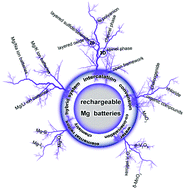A critical review of cathodes for rechargeable Mg batteries
Abstract
Benefiting from a higher volumetric capacity (3833 mA h cm−3 for Mg vs. 2046 mA h cm−3 for Li) and dendrite-free Mg metal anode, reversible Mg batteries (RMBs) are a promising chemistry for applications beyond Li ion batteries. However, RMBs are still severely restricted by the absence of high performance cathodes for any practical application. In this review, we provide a critical and rigorous review of Mg battery cathode materials, mainly reported since 2013, focusing on the impact of structure and composition on magnesiation kinetics. We discuss cathode materials, including intercalation compounds, conversion materials (O2, S, organic compounds), water co-intercalation cathodes (V2O5, MnO2etc.), as well as hybrid systems using Mg metal anode. Among them, intercalation cathodes are further categorized by 3D (Chevrel phase, spinel structure etc.), 2D (layered structure), and 1D materials (polyanion: phosphate and silicate), according to the diffusion pathway of Mg2+ in the framework. Instead of discussing every published work in detail, this review selects the most representative works and highlights the merits and challenges of each class of cathodes. Advances in theoretical analysis are also reviewed and compared with experimental results. This critical review will provide comprehensive knowledge of Mg cathodes and guidelines for exploring new cathodes for rechargeable magnesium batteries.



 Please wait while we load your content...
Please wait while we load your content...